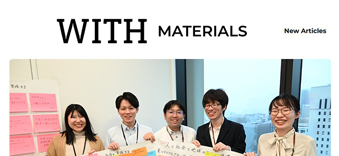- Home
- Sustainability Report
- Mitsubishi Materials Group's Initiatives on Material Issues
- Building and execution of new business creation processes
Pursuit of Value Creation
Building and Execution of New Business Creation Processes

Basic Policy on R&D
Developing New Products and Technologies to Anticipate Changes in the World around Us
Our basic policy when it comes to development is to develop materials in anticipation of the future, to create new products and technologies to strengthen business competitiveness by close cooperation of the Corporate/Division Laboratories, and to quickly realize R&D results through industry-academia-government collaboration (including CVC). With this policy in mind, we aim to "provide society with sustainable materials that design circulation."
Our research and development strategy calls for achieving sustainable enhancement of corporate value through the creation of new products, technologies, and new businesses through new products and process innovations that contribute to enhancing the functions of both the “artery” and “vein” of materials and reducing GHG. Aware of the direction that we should move forward in response to growing social demands for resource recycling, we will create themes for acquiring new resource recycling process technologies. At the same time, we will accurately grasp megatrends and market changes, and focus on growth areas (mobility, semiconductor-related materials) and new areas (life healthcare, etc.) while utilizing our materials technologies. We will also conduct research and development with a zero GHG philosophy in new themes. On a longer-term basis, we intend to boldly take on the challenge of creating inspirational new technologies for the future. Combining technology, human resources and passion, our aim is to continually achieve innovation, with an emphasis on the customer’s perspective and speed.
By combining our technical development capabilities based on our core technologies with our manufacturing abilities we will work to give shape to this value as we strive to create new products, services and businesses, and to perform maintenance of the intellectual properties.
Areas for Improvement from FYE March 2024 and Beyond
Under our new Medium-term Management Strategy, in the fiscal year ended March 2024 as its first year, we worked on achieving differentiation in our manufacturing abilities and promoted the upgrading of production processes and shifting to smart factories and worked to promote the creation of new businesses. We will also continue to engage in research and development, focusing on areas that reflect emerging megatrends including resource recycling, decarbonization, semiconductor-related materials and mobility.
On the organizational front, we have newly established the Monozukuri and R&D Strategy Div., consolidating departments related to manufacturing (production technology), development, marketing and new business to fully integrate everything from the creation of ideas and R&D through to mass production and commercialization. In the division's Innovation Center, we have set up a structure to efficiently utilize human resources along the lines of each R&D/manufacturing challenge or new business theme, enabling us to create new products and businesses, pursue development focused on solutions, and acquire new technologies. We have also established an Incubation Center, where we cultivate and strengthen businesses created in the Innovation Center, as well as businesses deemed difficult for an in-house company to expand on its own. To promote coordination inside and outside the Group, reinforce business foundations and advance the creation of new businesses as well as to aim to develop and secure professional human resources across the company and continuously improve their level of expertise, in the fiscal year ending March 2025 we have also established a New Business Development Dept., Intellectual Property Dept., Strategy and R&D Strategy Dept. and Monozukuri and Corporate Production Engineering Dept. inside the division.
Through these efforts, we will strengthen efforts to deal with the challenges we currently face, namely coordination across multiple strategies, the flexible allocation of management resources, and the development of human resources specializing in general project management, mass production and commercialization.
Implementation Structure

MMC Innovation Fund
In March 2019, we worked with JMTC Capital G.K. to establish the “MMC Innovation Investment Limited Partnership,” a corporate venture fund with the objective of investment in venture companies with material technologies.
We support technology start-ups that have synergies with us. In this, we accelerate collaboration with a focus on next-generation batteries, metal processing, IoT and AI, material technologies related to life and healthcare, and process technologies related to decarbonization and urban mines.
| Time | Investee | Investee's technologies/products | MMC’s aim |
|---|---|---|---|
| October 2019 | Elephantech Inc. | Elephantech has manufacturing technology for electronic circuit boards by additive manufacturing using inkjet printing of metal nano inks and electroless copper plating. | MMC has started development of “copper nano ink” with Elephantech as an evaluation partner. MMC will aim to develop new copper products for circuit boards and get opportunities of its supply. |
| May 2020 | EneCoat Technologies Co., Ltd. | EneCoat Technologies is developing Perovskite Solar Cells characterized by high power generation efficiency, light weight, and flexibility compared to conventional silicon-based solar cells. | In collaborate with EneCoat Technologies, MMC will develop technologies that contribute to improving the performance of Perovskite Solar Cells and the peripheral materials etc. necessary for making them lead-free, aiming to get opportunities to supply materials when perovskite solar cells become widespread. |
| June 2020 | CONNEXX SYSTEMS Corporation | CONNEXX SYSTEMS has development and manufacturing technologies for new storage battery, high-power in-vehicle Lithium-ion battery (LIB), and next-generation battery that combine LIB and lead-acid battery. | MMC is developing technology for reusing and recycling used in-vehicle LIB. In collaboration with CONNEXX SYSTEMS, MMC will promote the reuse business that is the reuse of collected used in-vehicle LIB for stationary storage battery. |
| September 2020 | Nature Architects inc. | Nature Architects has unique structure design technologies such as giving strength only to the necessary parts and adding the function of absorbing vibration to hard parts. | By combining MMC’s knowledge of non-ferrous metals and other material properties with Nature Architects’ design technology, MMC will promote development of unique products with new added value by additive manufacturing using our materials. |
| July 2021 | Immunosens Co., Ltd. | Immunosens Co., Ltd. develops and provides unique immunosensors for POCT (Point of Care Testing: real-time testing at medical sites) that are both highly sensitive and small in size through its patented GLEIA (Gold Linked Electrochemical Immuno Assay) technology. | Through collaboration with the company, MMC aims to find synergies between MMC's knowledge of materials, including nonferrous metals, and the company's life/healthcare-related technologies and expertise, and apply them to the life/healthcare field. |
| September 2024 | Visban Corporation | Visban Corporation develops millimeter wave network devices that enable high-speed transmission of large amounts of data, and, with connecting multiple devices simultaneously, provision of a less-congested communication environment. | Through collaboration with the company, MMC aims to make a significant contribution to the spread and expansion of 5G/6G communications by applying its strengths in materials required for microcircuit formation, dissimilar material bonding technology and its evaluation technology. |
| November 2024 | illuminus Inc. | illuminus Inc. develops and manufactures metal and alloy nanoparticles using its proprietary "pulsed-laser induced reduction." | Through collaboration with the company, MMC aims to develop technology for manufacturing new metal and alloy nanoparticles with a low environmental impact. |
- * This data is only available in Japanese on the website.
Intellectual Property Sector Initiatives
The strategic dialogue is promoted as an intellectual property activity in line with management, business and development strategies and new business strategies. In the strategic dialogue, we hold dialogues with the Companies and new business creation divisions based on the results of analyses of intellectual property information, and strategically formulate the intellectual property needed for business development. We support new value creation initiatives through various intellectual property activities, including strategic dialogue.

Major Achievements in FYE March 2024
- Commenced Commercialization of a Biosensor That Uses a Solid-Electrolyte Thin-Film Transistor
- Simultaneous Detection of Multiple Nucleic Acids and Pathogens in a Short Time - -
Mitsubishi Materials Corporation together with Professor Yuzuru Takamura and Assistant Professor Daisuke Hirose of the Bioscience, Biotechnology, and Biomedical Engineering Research Area at Japan Advanced Institute of Science and Technology (Nomi City, Ishikawa Prefecture) have developed a biosensor that uses a novel solid-electrolyte thin-film transistor and have started on product development towards its practical use.
Genetic testing in the medical field generally uses methods of testing that amplify nucleic acids such as the polymerase chain reaction (PCR) method, but their application is limited by the high cost and large size of testing equipment. Mitsubishi Materials has long been engaged in research and development to form thin films on a variety of materials including metals and oxides and has advanced technological capabilities in the materials development for thin film preparation by wet deposition. In this joint development, the technology has been applied to develop a new biosensor that uses a proprietary solid-electrolyte thin-film transistor as the detector (see the schematic diagram).
With this biosensor, test results can be obtained in a shorter time than with PCR or other amplification methods by detecting voltage changes caused by microcharges. In addition, multiple sensor elements can be arranged in parallel by using microfabrication technology, which enables simultaneous detection of multiple nucleic acids and pathogens. Furthermore, the small size of the solid-electrolyte thin-film transistor itself enables the miniaturization of biosensors, which is expected to expand applications for biosensors in the future.
From now on, we will expand the types of nucleic acids that can be measured, work on commercialization of sensors capable of simultaneous detection of pathogens including multiple types and promote product development for practical use.
Based on its Corporate Philosophy of "For People, Society and the Earth." Mitsubishi Materials will continue to help build a prosperous society through developing and providing high value-added products in the fields of non-ferrous metal materials and life healthcare.
Newly developed biosensor
- Property Prediction Model Built for Copper Alloys
- Supporting the Superiority of Mitsubishi Materials' Magnesium-Copper Alloy MSP™ Series - -
Mitsubishi Materials Corporation ("MMC") and the National Institute for Materials Science ("NIMS") have developed a new property prediction model for copper alloys with an exhaustive range of 86 elements. The results of the two organizations' joint research using this model revealed that magnesium (Mg) is the best overall element to be added to copper.
MMC and NIMS established the MMC-NIMS Center of Excellence for Materials Informatics Research in 2020 and have been engaged in research on data-integrated materials development systems. The joint research is achieved by combining MMC's copper alloy design and simulation technologies with NIMS' strength in "data-driven approach", a materials development method using data science.
For copper alloys, which are difficult to subject to real experiments from the viewpoint of stability, cost, and safety, the research used a combination of simulation technology and the data-driven approach to build a property prediction model capable of accurately predicting copper alloy properties, and compared various additive elements added to copper. As a result, it revealed that magnesium (Mg) is the best overall additive element to be added to copper. This demonstrated the superiority of the properties and quality of the MSP™ Series *, MMC's Cu-Mg solid-solution strengthened alloys.
Mitsubishi Materials and NIMS will continue to contribute to the improvement of the international competitiveness of the entire Japanese materials industry by deepening inter-organizational cooperation and promoting the dissemination and utilization of the obtained results.
Relationship between mechanical and electrical properties of solid-solution copper alloys
- ※ Solid-solution strengthening: A technique of dissolving foreign atoms (solute atoms) into the matrix (solvent atoms) to strengthen the material.







